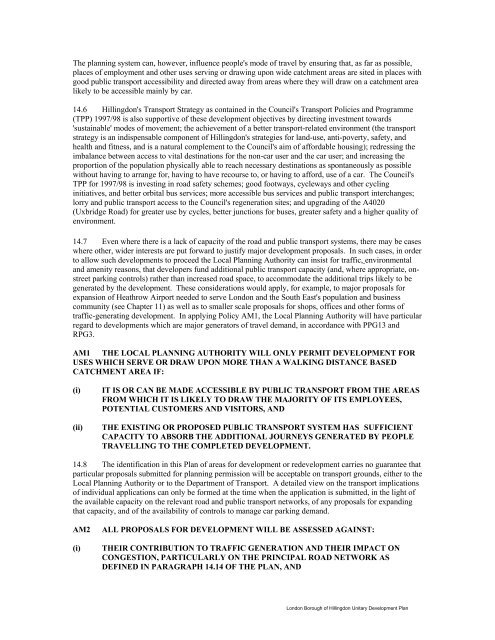HILLINGDON UNITARY DEVELOPMENT PLAN - London Borough ...
HILLINGDON UNITARY DEVELOPMENT PLAN - London Borough ...
HILLINGDON UNITARY DEVELOPMENT PLAN - London Borough ...
Create successful ePaper yourself
Turn your PDF publications into a flip-book with our unique Google optimized e-Paper software.
The planning system can, however, influence people's mode of travel by ensuring that, as far as possible,<br />
places of employment and other uses serving or drawing upon wide catchment areas are sited in places with<br />
good public transport accessibility and directed away from areas where they will draw on a catchment area<br />
likely to be accessible mainly by car.<br />
14.6 Hillingdon's Transport Strategy as contained in the Council's Transport Policies and Programme<br />
(TPP) 1997/98 is also supportive of these development objectives by directing investment towards<br />
'sustainable' modes of movement; the achievement of a better transport-related environment (the transport<br />
strategy is an indispensable component of Hillingdon's strategies for land-use, anti-poverty, safety, and<br />
health and fitness, and is a natural complement to the Council's aim of affordable housing); redressing the<br />
imbalance between access to vital destinations for the non-car user and the car user; and increasing the<br />
proportion of the population physically able to reach necessary destinations as spontaneously as possible<br />
without having to arrange for, having to have recourse to, or having to afford, use of a car. The Council's<br />
TPP for 1997/98 is investing in road safety schemes; good footways, cycleways and other cycling<br />
initiatives, and better orbital bus services; more accessible bus services and public transport interchanges;<br />
lorry and public transport access to the Council's regeneration sites; and upgrading of the A4020<br />
(Uxbridge Road) for greater use by cycles, better junctions for buses, greater safety and a higher quality of<br />
environment.<br />
14.7 Even where there is a lack of capacity of the road and public transport systems, there may be cases<br />
where other, wider interests are put forward to justify major development proposals. In such cases, in order<br />
to allow such developments to proceed the Local Planning Authority can insist for traffic, environmental<br />
and amenity reasons, that developers fund additional public transport capacity (and, where appropriate, onstreet<br />
parking controls) rather than increased road space, to accommodate the additional trips likely to be<br />
generated by the development. These considerations would apply, for example, to major proposals for<br />
expansion of Heathrow Airport needed to serve <strong>London</strong> and the South East's population and business<br />
community (see Chapter 11) as well as to smaller scale proposals for shops, offices and other forms of<br />
traffic-generating development. In applying Policy AM1, the Local Planning Authority will have particular<br />
regard to developments which are major generators of travel demand, in accordance with PPG13 and<br />
RPG3.<br />
AM1 THE LOCAL <strong>PLAN</strong>NING AUTHORITY WILL ONLY PERMIT <strong>DEVELOPMENT</strong> FOR<br />
USES WHICH SERVE OR DRAW UPON MORE THAN A WALKING DISTANCE BASED<br />
CATCHMENT AREA IF:<br />
(i)<br />
(ii)<br />
IT IS OR CAN BE MADE ACCESSIBLE BY PUBLIC TRANSPORT FROM THE AREAS<br />
FROM WHICH IT IS LIKELY TO DRAW THE MAJORITY OF ITS EMPLOYEES,<br />
POTENTIAL CUSTOMERS AND VISITORS, AND<br />
THE EXISTING OR PROPOSED PUBLIC TRANSPORT SYSTEM HAS SUFFICIENT<br />
CAPACITY TO ABSORB THE ADDITIONAL JOURNEYS GENERATED BY PEOPLE<br />
TRAVELLING TO THE COMPLETED <strong>DEVELOPMENT</strong>.<br />
14.8 The identification in this Plan of areas for development or redevelopment carries no guarantee that<br />
particular proposals submitted for planning permission will be acceptable on transport grounds, either to the<br />
Local Planning Authority or to the Department of Transport. A detailed view on the transport implications<br />
of individual applications can only be formed at the time when the application is submitted, in the light of<br />
the available capacity on the relevant road and public transport networks, of any proposals for expanding<br />
that capacity, and of the availability of controls to manage car parking demand.<br />
AM2<br />
(i)<br />
ALL PROPOSALS FOR <strong>DEVELOPMENT</strong> WILL BE ASSESSED AGAINST:<br />
THEIR CONTRIBUTION TO TRAFFIC GENERATION AND THEIR IMPACT ON<br />
CONGESTION, PARTICULARLY ON THE PRINCIPAL ROAD NETWORK AS<br />
DEFINED IN PARAGRAPH 14.14 OF THE <strong>PLAN</strong>, AND<br />
<strong>London</strong> <strong>Borough</strong> of Hillingdon Unitary Development Plan
















